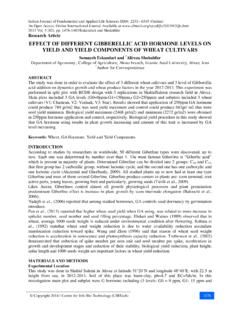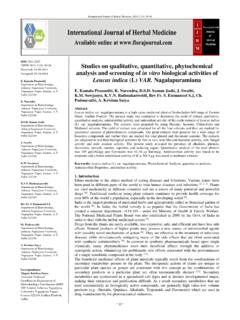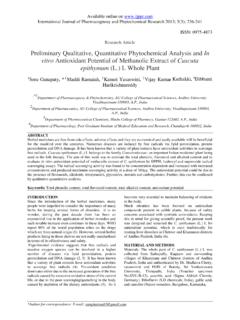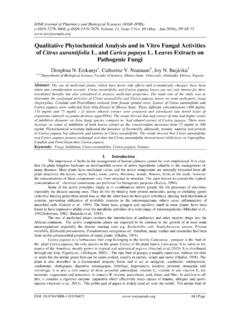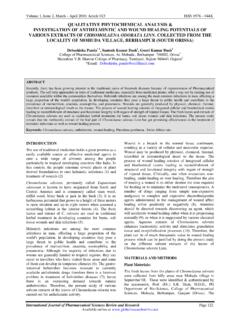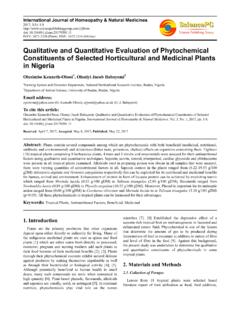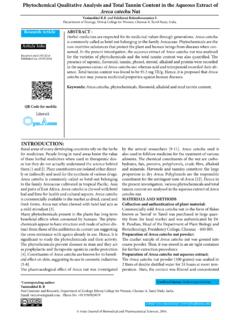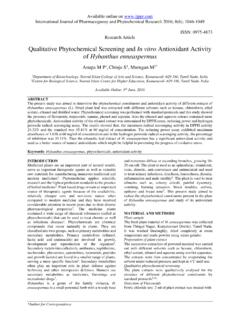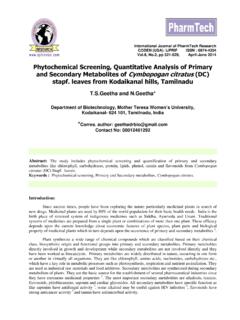Transcription of QUALITATIVE PHYTOCHEMICAL ANALYSIS OF MADHUCA ... …
1 Indian Journal of Plant Sciences ISSN: 2319 3824(Online) An Open Access, Online International Journal Available at 2014 Vol. 3 (4) October-December, pp. 38-41/Kamal Research Article Copyright 2014 | Centre for Info Bio Technology (CIBTech) 38 QUALITATIVE PHYTOCHEMICAL ANALYSIS OF MADHUCA LONGIFOLIA *Azra Kamal Forensic Science Laboratory, (Police), Patna-800023, Bihar, India *Author for Correspondence ABSTRACT Medicinal plants are having a great importance to pharmaceutical industry because these are rich source of drugs and a vast reservoir of chemical diversity for screening programs aimed at new drug discovery.
2 MADHUCA longifolia is one of the universal plant having medicinal activities. In this present study an attempt has been made to screen PHYTOCHEMICAL profile of MADHUCA longifolia leaves. The presence of some bioactive substances established PHYTOCHEMICAL activity of the MADHUCA longifolia leaves which supports the traditional medicinal utilization of the plant. Further biological study is required to explore their potential therapeutic activities. Keywords: Phytochemicals, MADHUCA Longifolia Leaves, Methanol Extract, Aqueous Extract and Medicinal Plants INTRODUCTION Plants are being an effective source of both traditional and modern medicines are genuinely useful for primary healthcare.
3 The medicinal plants produce wide range array of bioactive molecules and rich source of medicines (Agharkar, 1991). Traditional healing systems around the world that utilize herbal remedies are an important source for the discovery of new antibiotics (Okpekon et al., 2004). The secondary metabolites are the important substance responsible for the main medicinal properties in the crude drugs (Sengar and Agarwal, 2009). MADHUCA longifolia belongs to the family Sapotaceae. It is a medium sized deciduous tree distributed in Nepal, India and Srilanka (Saluja et al.)
4 , 2011). Previous PHYTOCHEMICAL studies on MADHUCA indica included characterization of sapogenins, triterpenoids, steroids, saponins, flavonoids and glycosides (Kumar et al., 2011). The medicinal properties attributed to this plant are stimulant, demulcent, emollient, heating and astringent (Awashthi and Mitra, 1967). The flowers have been traditionally used as cooling agent, tonic, aphrodisiac, and astringent, demulcent and for the treatment of helminthes, acute and chronic tonsillitis, pharyngitis as well as bronchitis (Chandra 2001).
5 MADHUCA longifolia leaves are expectorant and also used for chronic bronchitis, Cushing s disease, verminosis, gastropathy, dipsia, bronchitis, consumption, dermatopathy, rheumatism, cephalgia and hemorrhoids. The seeds fat has emuluscent property, used in skin disease, rheumatism, headache, laxative, piles and sometimes as galactogogue. The bark is used for rheumatism, chronic bronchitis, diabetes mellitus, decoction for rheumatism, bleeding and spongy gums. It is a good remedy for itch, swelling, fractures and snake- bite poisoning, internally employed in diabetes mellitus, fruits are astringent and largely employed as a lotion in chronic ulcer, in acute and chronic tonsillitis and pharyngitis (Sunita and Sarojini, 2013).
6 Preliminary PHYTOCHEMICAL screening of the plants is primarily an important aspect in finding the chemical constituents in plant materials. Hence, the present investigation is carried out to find out the phytochemicals present in the leaves of MADHUCA longifolia. MATERIALS AND METHODS Collection of Plant Material and Extraction The fresh leaves of MADHUCA longifolia were collected from Sitamarhi district of Bihar, India. The shade dried, coarsely powdered leaf material was extracted successively with methanol and aqueous using soxhlet apparatus.
7 Extract were obtained and used for further PHYTOCHEMICAL ANALYSIS . Indian Journal of Plant Sciences ISSN: 2319 3824(Online) An Open Access, Online International Journal Available at 2014 Vol. 3 (4) October-December, pp. 38-41/Kamal Research Article Copyright 2014 | Centre for Info Bio Technology (CIBTech) 39 PHYTOCHEMICAL QUALITATIVE ANALYSIS Freshly prepared extracts were subjected to PHYTOCHEMICAL evaluation for the detection of various PHYTOCHEMICAL constituents using conventional protocol (Harborne, 1992), (Kokate, 1994).
8 Alkaloids (Hager s test): 3ml of dilute hydrochloric acid was added to the small amount of extract and filtered. Filtrate was mixed with 2ml of Hager s reagent; formation of a yellow precipitate was regarded as positive for the presence of alkaloids. Carbohydrates (Molish s test): 2ml of extract was mixed with 1ml of Molisch s reagent; 2ml of concentrated H2SO4 was poured carefully along the side of the test tube. Appearance of a violet ring at the interphase indicated the presence of carbohydrate.
9 Proteins (Biuret test): Small amount of copper sulphate solution was added with 5ml of extract, NaOH solution was mixed, violet color appeared suggesting the presence of proteins. Saponins (Froth test): 2ml extract was mixed with 15ml of distilled water, shaken vigorously. Formation of foam was taken as an indication for the presence of saponins. Tannins (Lead acetate test): A small amount of extract was treated with lead acetate and observed for the formation of white precipitate which shows presence of tannins.
10 Triterpinoids (Noller s test): A small amount of extract was heated with tin and thionyl chloride, formation of pink color was an indication of the presence of triterpinoids. Gums/Mucilage: The extract was mixed with water, no thickening of the substances occur indicates absence of gums. Fixed oils & Fats: A small quantity of extract pressed between the filter papers. No formation of oil spot indicates the absence of fixed oils and fats. Table 1: PHYTOCHEMICAL screening of leaf extracts of MADHUCA longifolia PHYTOCHEMICAL Tests Methanol extract Aqueous extract Alkaloids + + Carbohydrates + + Proteins + + Saponins + + Tannins + + Triterpinoids + + Gums/Mucilage - - Fixed oils & Fats - - + Present, - Absent RESULTS AND DISCUSSION Results The present study was carried out on the leaf extracts of MADHUCA longifolia revealed the presence of alkaloids, carbohydrates, proteins, saponins, tannins.





